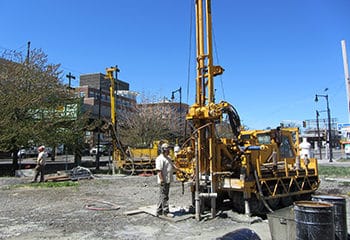
By Al Jones, PE, Director of Geotechnical Services
Developers and Owners are often trying to reduce costs in every way possible and who can blame them? One way to cut costs is to minimize the geotechnical design by reducing the subsurface exploration program. While this provides some short-term savings, it ignores the value of a thorough geotechnical investigation and adds considerable risk to your project.
We’ll often be asked, “Can the borings be completed in one day instead of two?” A thin subsurface exploration program might save time and money in the beginning of a project, but often, this decision will result in a more conservative design. This approach doesn’t allow you to evaluate all possible design options, and you could be adding unnecessary construction costs like pouring more concrete for a larger foundation you never needed.
In addition, the lack of information gathered from the limited investigation may result in a significant change order during construction to address unanticipated conditions, which will be significantly more costly than just completing a more comprehensive exploration. It’s cheaper to spend the money on a few more days of drilling than to have a million-dollar change order for blasting due to high bedrock conditions that were never discovered due to a limited number of borings.
Every project requires a different level of effort for the geotechnical exploration. The variability of subsurface conditions at each site is especially prominent in the Northeast. I’ve been a geotechnical engineer for over 25 years and I am still surprised by variations in subsurface conditions at some sites. Perhaps it might be fill that looks like natural soils, perched groundwater that is mistaken for the actual groundwater table, or assumed bedrock that may be just a large boulder. To ensure there are no surprises, rarely should a project in the Northeast be getting by on one-day of drilling, except for the smallest of projects.
So, what should an Owner or Developer do? Find a geotechnical engineering firm that will provide you with the most complete and cost effective design. This will save you from the pains of increasing costs and project delays. Here’s how:
First, compare competitive proposals from your geotechnical consultants and evaluate how they align with your project’s needs. Let’s say your new facility is proposed to be built on undeveloped land where no historical information of the subsurface exists. Firm A’s proposal calls for multiple days of explorations and rock coring, while Firm B’s calls for only a couple of shallow 20-foot borings. It would be more beneficial to hire Firm A and complete a more comprehensive investigation that provides an accurate picture of the subsurface profile.
Next, investigate the experience and qualifications of each competing firm. They should have experience working on your type of site and will have insight into the challenges that your design may encounter. Good firms have a history of working with design teams to understand the planned development and will prepare detailed scope of services that ensure your design needs are met. This should all be illustrated in their proposal.
Finally, don’t be afraid to engage in direct conversation with your design team. We understand that you want to complete the project for the most reasonable price at the fastest pace. If you feel that a proposed scope of work is bloated, ask your engineer about it. A good design firm will provide you feedback explaining why that extra day of drilling may be needed. They will review the risks and challenges with you and explain what the best solutions are. These conversations will provide you the confidence to push forward without worrying about your investment.